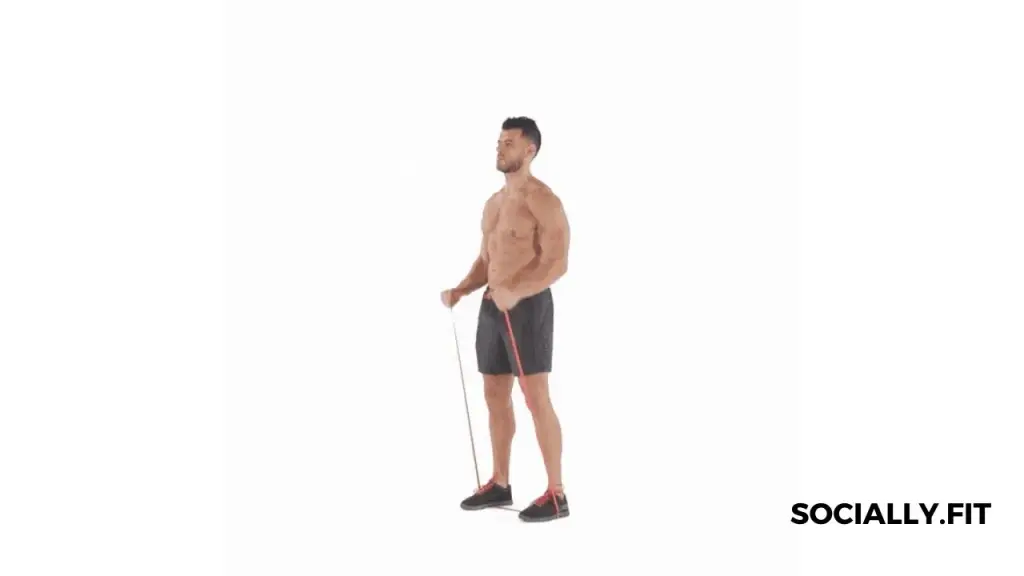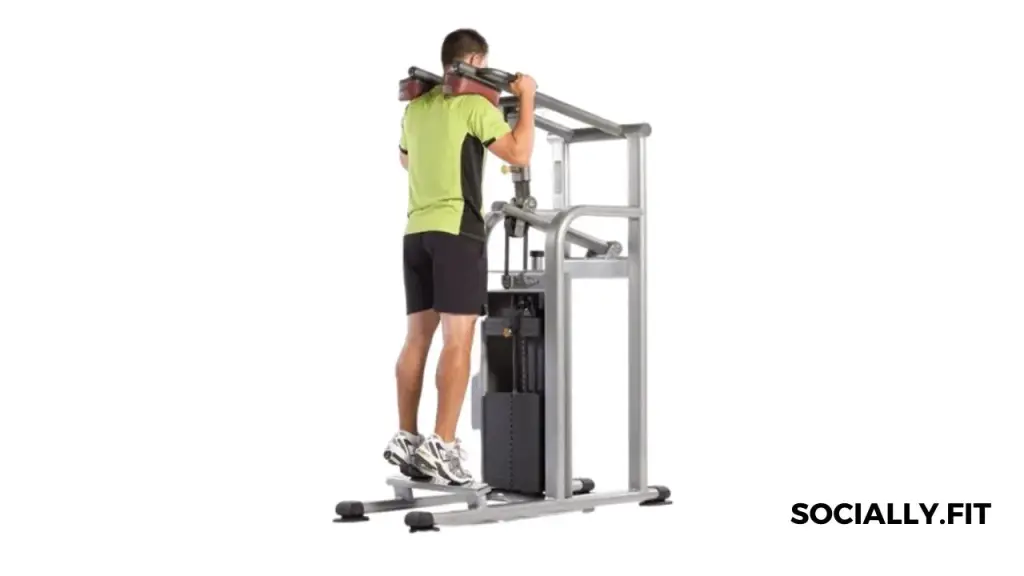Biceps Tendonitis Exercises: Alleviate Pain and Improve Mobility.
Discover a range of targeted exercises to manage biceps tendonitis effectively. From gentle stretches to strengthening routines, learn how to alleviate pain and enhance mobility for better shoulder health.
Introduction
Biceps tendonitis is a common condition characterized by inflammation or irritation of the biceps tendon. It often occurs due to overuse or repetitive movements, leading to pain and discomfort in the affected area. In this article, we will explore exercises and strategies to manage biceps tendonitis effectively.
Exercises for Biceps Tendonitis
Regular exercise is essential for promoting healing and preventing recurrence of biceps tendonitis. Here are some effective exercises:
Doorway Stretch:
Stand in a doorway with your hands on the door frame, then lean forward to stretch the biceps and chest muscles.

Cross-Body Arm Stretch:
Extend one arm across your body and gently press the elbow with the opposite hand to stretch the biceps.

Shoulder Flexion Stretch:
Stand or sit and gently raise one arm overhead, bending at the elbow, to stretch the biceps and shoulder.

Triceps Stretch:
Extend one arm overhead and reach the hand down the center of your back, gently pulling the elbow with the opposite hand to stretch the triceps and biceps.

Wrist Flexor Stretch:
Extend one arm in front of you with the palm facing up, then use the opposite hand to gently press the fingers back to stretch the wrist flexors and biceps.

Wrist Extensor Stretch:
Extend one arm in front of you with the palm facing down, then use the opposite hand to gently press the fingers down to stretch the wrist extensors and biceps.

Standing Wall Stretch:
Stand facing a wall and place your palms flat against it at shoulder height, then lean forward to stretch the biceps and chest muscles.

Prayer Stretch:
Sit on your heels with your arms extended in front of you and palms together, then lower your chest toward the floor to stretch the biceps and shoulders.

Resistance Band Curl:
Sit or stand with a resistance band under your foot and hold one end in each hand, then curl the hands toward the shoulders to strengthen the biceps.

Hammer Curl:
Hold a dumbbell in each hand with palms facing each other, then curl the weights toward the shoulders while keeping the palms parallel to the body.

Reverse Curl:
Hold a barbell or dumbbells with palms facing down, then curl the weights toward the shoulders while keeping the palms facing the floor to target the forearm muscles and biceps.

Concentration Curl:
Sit on a bench with one arm resting against the inner thigh and the elbow slightly bent, then curl a dumbbell toward the shoulder while keeping the upper arm stationary.

Preacher Curl:
Sit or stand at a preacher bench with the upper arms resting against the pad, then curl a barbell or dumbbells toward the shoulders to isolate the biceps.

Incline Curl:
Lie face-up on an incline bench with arms hanging down and palms facing forward, then curl the weights toward the shoulders while keeping the elbows stationary.

Eccentric Curl:
Hold a dumbbell in one hand and slowly lower it back down to the starting position, focusing on the eccentric (negative) phase of the movement to strengthen the biceps.

Isometric Hold:
Hold a dumbbell or resistance band at a 90-degree angle with the elbow bent, then hold the position for a few seconds to strengthen the biceps without movement.

Pronation-Supination:
Hold a dumbbell with palms facing down and slowly rotate the forearm outward (supination), then rotate it back inward (pronation) to work the biceps and forearm muscles.

Dumbbell Pullover:
Lie face-up on a bench with a dumbbell in both hands extended overhead, then lower the weight behind the head while keeping the arms straight to stretch the biceps.

Cable Curl:
Attach a cable handle to a low pulley and hold it with palms facing up, then curl the handle toward the shoulders while keeping the elbows stationary to target the biceps.

Suspension Trainer Curl:
Hold onto suspension trainer handles with palms facing up and lean back at an angle, then curl the body toward the handles to work the biceps and core stability.

These exercises should be performed under the guidance of a qualified fitness professional or physical therapist, and it’s essential to start with light weights and gradually increase intensity to avoid exacerbating biceps tendonitis symptoms.
Causes of Biceps Tendonitis
- Overuse: Engaging in repetitive overhead activities, such as lifting weights or throwing sports like baseball or tennis, can strain the biceps tendon and lead to inflammation.
- Poor Posture: Maintaining improper posture during activities can put excessive stress on the biceps tendon, especially if the shoulders are rounded forward or the head is protruded.
- Age-related Changes: As individuals age, the tendons in the body may become less flexible and more prone to injury, making older adults more susceptible to biceps tendonitis.
- Muscle Imbalance: Weakness or tightness in surrounding muscles, such as the rotator cuff muscles or scapular stabilizers, can alter shoulder mechanics and contribute to biceps tendonitis.
- Sudden Increase in Activity: Abruptly increasing the intensity, duration, or frequency of physical activity without proper conditioning or warm-up can overload the biceps tendon and cause inflammation.
- Trauma or Injury: Direct trauma to the shoulder or elbow joint, such as a fall or blow to the arm, can damage the biceps tendon and trigger tendonitis.
- Repetitive Strain: Performing repetitive tasks or movements that involve lifting, pulling, or reaching overhead, such as painting or carpentry work, can gradually wear down the biceps tendon and lead to tendonitis.
- Sports Participation: Participation in certain sports or activities that involve repetitive arm motions, such as swimming, golf, or weightlifting, can increase the risk of biceps tendonitis.
Symptoms of Biceps Tendonitis
- Pain: Persistent or intermittent pain in the front of the shoulder or elbow, particularly during activities that involve lifting, reaching, or overhead movements.
- Tenderness: Sensitivity or discomfort when touching or palpating the biceps tendon, which may feel tender or swollen to the touch.
- Swelling: Visible swelling or puffiness around the biceps tendon, especially in the front of the shoulder or upper arm area.
- Warmth: Increased warmth or heat sensation over the affected biceps tendon, often accompanied by redness or inflammation in the surrounding area.
- Weakness: Decreased strength or muscle function in the affected arm, making it difficult to perform everyday tasks or activities that require lifting or carrying objects.
- Stiffness: Reduced flexibility or range of motion in the shoulder or elbow joint, particularly when attempting to lift the arm overhead or reach behind the back.
- Crunching Sensation: Occasionally, individuals with biceps tendonitis may experience a popping, clicking, or crunching sensation in the shoulder or elbow joint during movement.
- Night Pain: Discomfort or pain that worsens at night, particularly when lying on the affected side or attempting to sleep with the arm in certain positions.
How do stretching exercises differ from strengthening exercises in their approach to managing biceps tendonitis?
| Aspect | Stretching Exercises | Strengthening Exercises |
|---|---|---|
| Purpose | Focus on increasing flexibility and reducing tension in the biceps tendon and surrounding muscles. | Aim to build strength and endurance in the muscles supporting the biceps tendon, promoting stability and resilience. |
| Mechanism of Action | Involve elongating the muscle fibers through gentle, sustained stretches, promoting relaxation and improved range of motion. | Require the muscles to generate force against resistance, stimulating muscle growth and enhancing overall muscle function. |
| Application | Typically performed during the early stages of biceps tendonitis to alleviate acute pain and inflammation. | Often introduced during the later stages of rehabilitation to gradually load and strengthen the affected muscles. |
| Examples | Doorway stretch, cross-body arm stretch, shoulder flexion stretch. | Resistance band curls, dumbbell hammer curls, eccentric curls. |
| Frequency and Duration | Can be performed multiple times throughout the day for short durations, focusing on gentle, controlled movements. | Usually performed 2-3 times per week for longer durations, gradually increasing intensity and resistance over time. |
Analysis:
Stretching exercises primarily target flexibility and tension relief in the biceps tendon and surrounding muscles, promoting relaxation and improved range of motion. These exercises are often introduced during the early stages of biceps tendonitis to alleviate acute pain and inflammation.
Strengthening exercises, on the other hand, aim to build strength and endurance in the muscles supporting the biceps tendon, enhancing stability and resilience. They typically involve generating force against resistance, stimulating muscle growth and improving overall muscle function. These exercises are commonly incorporated into the later stages of rehabilitation to gradually load and strengthen the affected muscles.
What are the key differences between conservative treatments and surgical interventions for biceps tendonitis?
| Aspect | Conservative Treatments | Surgical Interventions |
|---|---|---|
| Approach | Non-invasive methods aimed at relieving symptoms and promoting healing without surgical intervention. | Invasive procedures performed to repair or reconstruct the damaged biceps tendon and surrounding structures. |
| Effectiveness | May effectively manage mild to moderate cases of biceps tendonitis, providing relief and promoting recovery in many patients. | Typically reserved for severe or chronic cases of biceps tendonitis that do not respond to conservative treatments. |
| Risks and Complications | Generally considered low-risk with minimal potential for complications, such as allergic reactions or skin irritation. | Carry higher risks of complications, including infection, nerve damage, or prolonged rehabilitation periods. |
| Recovery Time | Often associated with shorter recovery times, allowing patients to resume normal activities relatively quickly. | Tend to involve longer recovery periods due to the invasive nature of the procedures and the need for extensive rehabilitation. |
| Long-term Outcomes | Can yield favorable long-term outcomes in many cases, especially when combined with proper rehabilitation and preventive measures. | Success rates vary depending on the specific surgical technique used, the severity of the condition, and individual patient factors. |
Analysis:
Conservative treatments for biceps tendonitis are non-invasive approaches focused on relieving symptoms and promoting healing without surgical intervention. These methods, such as rest, physical therapy, and medication, are generally effective for managing mild to moderate cases of biceps tendonitis, with minimal risks and shorter recovery times compared to surgical interventions.
Surgical interventions, on the other hand, involve invasive procedures aimed at repairing or reconstructing the damaged biceps tendon and surrounding structures. These procedures are typically reserved for severe or chronic cases of biceps tendonitis that do not respond to conservative treatments. While surgical interventions may offer potential long-term benefits, they carry higher risks of complications and require longer recovery periods. Success rates vary depending on factors such as the surgical technique used and individual patient characteristics.
Conclusion

In conclusion, biceps tendonitis is a painful condition that can significantly impact daily activities and quality of life. It often arises from overuse, poor posture, or age-related changes in the tendons.
The symptoms of biceps tendonitis, including pain, swelling, and weakness, can be managed through various treatment options such as rest, physical therapy, and, in severe cases, surgical intervention.
Additionally, incorporating stretching and strengthening exercises into a regular routine can help alleviate symptoms and prevent future occurrences of biceps tendonitis.
By understanding the causes, symptoms, and treatment options for biceps tendonitis, individuals can take proactive steps to protect their shoulder health and maintain an active lifestyle.
FAQ

Can biceps tendonitis heal on its own?
In mild cases, biceps tendonitis may resolve with rest and conservative treatments. However, severe or chronic cases may require medical intervention.
Are there any specific exercises to avoid with biceps tendonitis?
Avoid exercises that put excessive strain on the biceps tendon, such as heavy lifting or repetitive overhead movements.
How long does it take to recover from biceps tendonitis?
The recovery time for biceps tendonitis varies depending on the severity of the injury and individual factors. With proper treatment and rehabilitation, most people can expect to recover within a few weeks to months.
Is surgery always necessary for biceps tendonitis?
Surgery is typically reserved for cases of biceps tendonitis that do not respond to conservative treatments. Your healthcare provider will assess your condition and recommend the most appropriate treatment approach.
Can biceps tendonitis recur after treatment?
Yes, biceps tendonitis can recur, especially if preventive measures are not followed or if there is repeated stress on the tendon. It’s essential to continue with stretching, strengthening, and proper technique to reduce the risk of recurrence.














